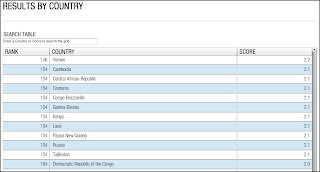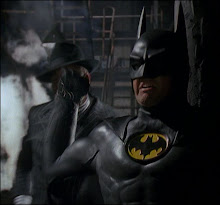Vladimir Putin's past is catching up with him.
From Vladimir Putin dogged by recent corruption scandals, March 15, 2011 (which I first found reprinted in Georgian Daily; I have reproduced links found in the original):
Transparency International's 2010 report categorizes countries on a ten-point scale. Countries with scores above 9 are considered "very clean", while countries with scores below 1 would be considered "highly corrupt". The lowest score, 1.1, placed Somalia in 178th place. With a score of 2.1, Russia tied for 154th place. (By comparison, the United States, with a score of 7.1, tied with Belgium for 22nd place.)
Continuing with Vladimir Putin dogged by recent corruption scandals:
In response, the palace was quietly sold "to a little-known businessman named Alexander Ponomarenko."
Skipping down in Vladimir Putin dogged by recent corruption scandals:
Here I review a paragraph from page 6 of Globalization and Transnational Organized Crime: The Russian Mafia in Latin America and the Caribbean by Bruce Michael Bagley, dated November 15, 2002; I interrupt in mid-paragraph with my own comments:
Was it? Was that the intent - to strengthen the newly-free society?
Continuing with the paragraph from page 6 of Globalization and Transnational Organized Crime: The Russian Mafia in Latin America and the Caribbean:
Or, did people in western governments use that intent as cover to organize crime in Russia along lines that might be conducive to their own interests? Perhaps to get Russia down and kick her, so there would be no one to contest the power of a triumphant America? Or, perhaps making things conducive to the business of the organized crime faction that had those western officials on its payroll?
Skipping down:
Temporary, not long-term... has that changed? Anyway, does it matter? Mafioso-temp agencies; work a deal to get the specific results you want, without having unnecessary criminals on your organization's payroll...
Continuing (I fixed a typo):
So, Putin wanted to force lawfulness on Russia, but then, as President, and now as Prime Minister, he has consolidated his power and the power of the criminal factions he represents.
Now, there is change we can believe in!
From Vladimir Putin dogged by recent corruption scandals, March 15, 2011 (which I first found reprinted in Georgian Daily; I have reproduced links found in the original):
MOSCOW, Russia — That Russia is one of the most corrupt countries on earth has become a given.
Usually, that fact is illustrated by numbers: Transparency International ranks Russia near the bottom of its corruption perceptions index (at 154), well below any other Group of Eight nation and even below such winners as Egypt (98) and Libya (146).
Transparency International's 2010 report categorizes countries on a ten-point scale. Countries with scores above 9 are considered "very clean", while countries with scores below 1 would be considered "highly corrupt". The lowest score, 1.1, placed Somalia in 178th place. With a score of 2.1, Russia tied for 154th place. (By comparison, the United States, with a score of 7.1, tied with Belgium for 22nd place.)
Continuing with Vladimir Putin dogged by recent corruption scandals:
But in the past few weeks, two scandals have given an unexpected face — that of Prime Minister Vladimir Putin — to what the Russian leadership has termed the country's biggest problem.
The two scandals — one involving a secret villa and the other a sham charity concert — prove that corruption, having seeped into every aspect of Russian life, leaves no one untouchable.
News of what has become known as the "Putin Palace" first emerged in December, when businessman Sergei Kolesnikov wrote an open letter to President Dmitry Medvedev calling on him to investigate the powerful prime minister for alleged corruption.
"Corruption can only be eradicated if the effort commences at the top and goes all the way to the bottom," Kolesnikov wrote. His letter was an insider's tale that recounted the construction of a 3,000-square-foot mansion being built on the Black Sea which, he alleged, was to be used by Putin as a vacation home.
In response, the palace was quietly sold "to a little-known businessman named Alexander Ponomarenko."
Skipping down in Vladimir Putin dogged by recent corruption scandals:
Soon after the sale, a second scandal erupted, this time involving a charity concert in St. Petersburg, attended by Hollywood elite, ostensibly to raise funds to help children with cancer. It was at that fundraiser, organized by an unknown charity called Federation Fund, where Putin took to the stage to sing his now famous rendition of "Blueberry Hill."
This scandal also broke with an open letter, from the mother of one of the sick children who expected to receive help. "It's been three months since [the concert]," wrote Olga Kuznetsova, whose daughter received a highly publicized visit from Sharon Stone ahead of the event. "There's no money, no help, no fund even." A doctor at Hospital 31, where Kuznetsova's daughter is receiving treatment, confirmed to Russian media that it had gotten no money after the charity concert.
The fund — which has no public listing, no website — was allegedly registered just ahead of the event. Its head is Vladimir Kiselyov, a Soviet-era rock star and St. Petersburg native who is said to have been a classmate of Putin's.
Here I review a paragraph from page 6 of Globalization and Transnational Organized Crime: The Russian Mafia in Latin America and the Caribbean by Bruce Michael Bagley, dated November 15, 2002; I interrupt in mid-paragraph with my own comments:
Western donor nations generally and the United States specifically may have contributed indirectly to undermining or weakening the Russian state and others in Eastern and Central Europe in the 1990s through their misdirected aid policies. Fearing that Communist party bureaucratic holdovers might seize control of, or improperly divert, Western assistance flows into Russia and other former Soviet bloc countries, whenever possible most international donors channeled their assistance through non-governmental organizations (NGOs) rather than through existing state institutions. The intent was to help strengthen the region's embryonic civil societies in the post-Soviet period while undercutting entrenched and corrupt bureaucratic authorities.
Was it? Was that the intent - to strengthen the newly-free society?
Continuing with the paragraph from page 6 of Globalization and Transnational Organized Crime: The Russian Mafia in Latin America and the Caribbean:
Good intentions notwithstanding, such policies, in practice, did not prevent Western aid resources from being siphoned off by the region's proliferating organized crime groups and may even have facilitated criminal enterprises of various sorts by circumventing state controls altogether. Simultaneously, such aid practices unquestionably further reduced the authority and impact of already debilitated state institutions while limiting international donors' leverage in support of effective institutional reforms.15
Or, did people in western governments use that intent as cover to organize crime in Russia along lines that might be conducive to their own interests? Perhaps to get Russia down and kick her, so there would be no one to contest the power of a triumphant America? Or, perhaps making things conducive to the business of the organized crime faction that had those western officials on its payroll?
Skipping down:
The U.S. government's interagency working group on international crime observes that over the latter 1990s the traditional domination of the "thieves-in-law" or "godfathers" of Russian crime gradually began to yield to a new breed of more "...flamboyant, aggressive and politically savvy ..." Russian criminals "...well-versed in modern technology and business practices that allow them to operate efficiently across international borders."18 Perhaps the most powerful of this new breed of Russian crime syndicates in terms of wealth, influence and financial control is the Solntsevo group known as Solntsevskaya. Solntsevskaya dominates Moscow's criminal underworld – including the drug market – and is reputed to have extensive worldwide operations involving arms and narcotics trafficking and money laundering operations.19 These overseas contacts and alliances do not, however, signal the emergence of a vast, centrally directed Russian underworld empire. Rather most Russian international criminal networks appear to be made up of "alliances of convenience" that are temporary and impermanent, not long-term and strategic.20
Temporary, not long-term... has that changed? Anyway, does it matter? Mafioso-temp agencies; work a deal to get the specific results you want, without having unnecessary criminals on your organization's payroll...
Continuing (I fixed a typo):
With the transition from the presidency of Boris Yeltsin to that of Vladimir Putin in 1999-2000, the political pendulum in Russia may have begun to swing back toward the construction of a stronger Russian state, one perhaps more authoritarian than democratic.21 Public opinion in Russia has exhibited overwhelming concern in recent years with the construction of a "strong state" capable of reining in rampant lawlessness and corruption. Putin himself has repeatedly referred to the need for imposing "the dictatorship of law". Skeptical observers, however, note that President Putin himself is the product of the very oligarchical system created under Yeltsin and that he has publicly rejected the popular idea of investigating the results of Russia's highly questionable privatizations of former state-owned enterprises during the 1990s for legal improprieties, cronyism and corruption. If, as Margaret Beare emphasizes, "...the meaning of the 'dictatorship of law' should turn out to be protection of the gains of the beneficiaries of the legal vacuum, then the main sources of Russian organized crime and corruption are likely to remain unaffected."22
So, Putin wanted to force lawfulness on Russia, but then, as President, and now as Prime Minister, he has consolidated his power and the power of the criminal factions he represents.
Now, there is change we can believe in!























